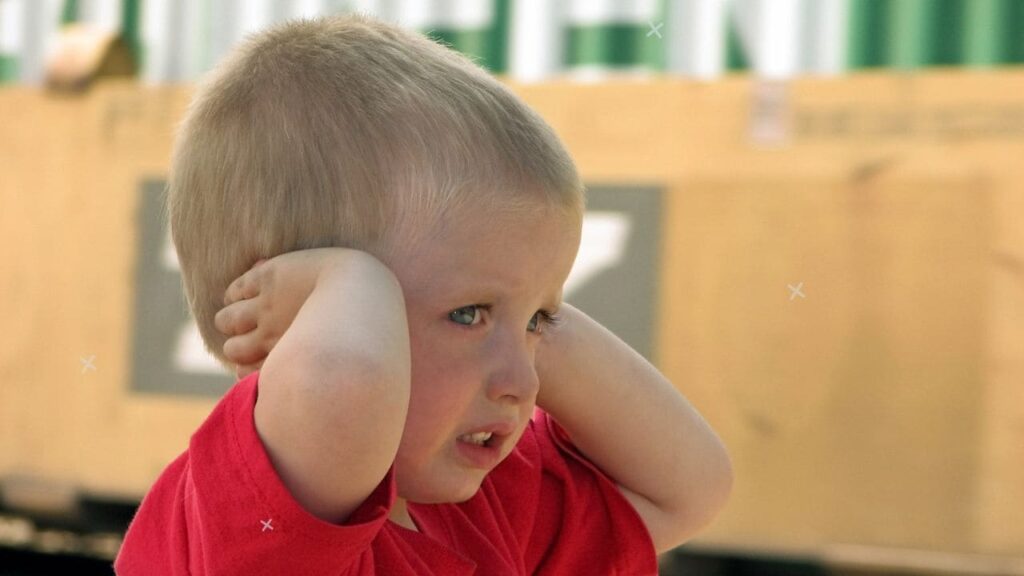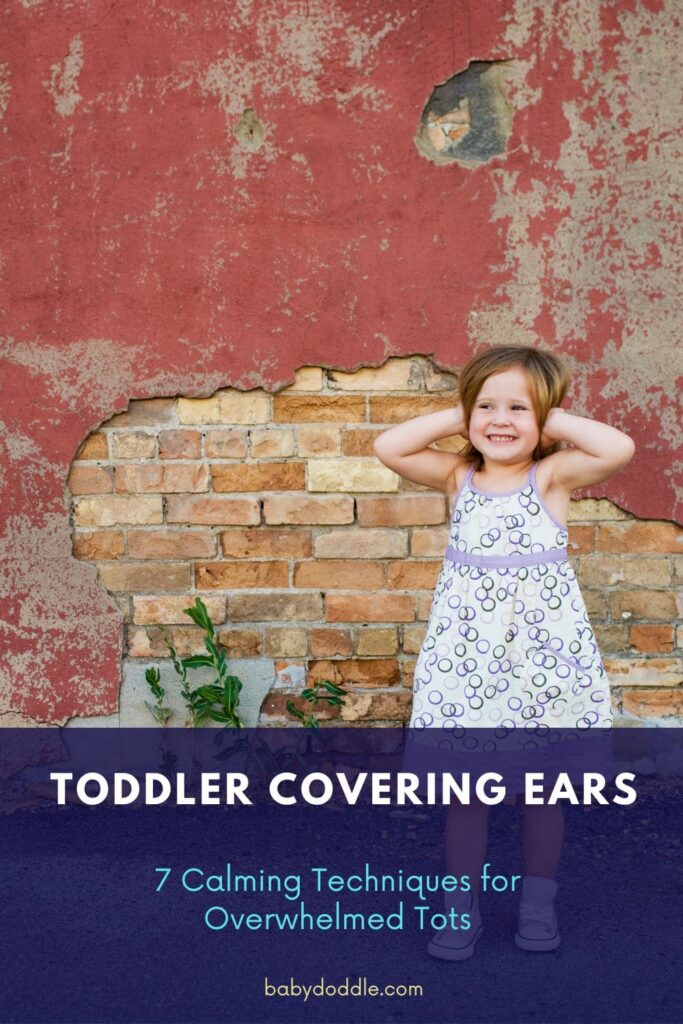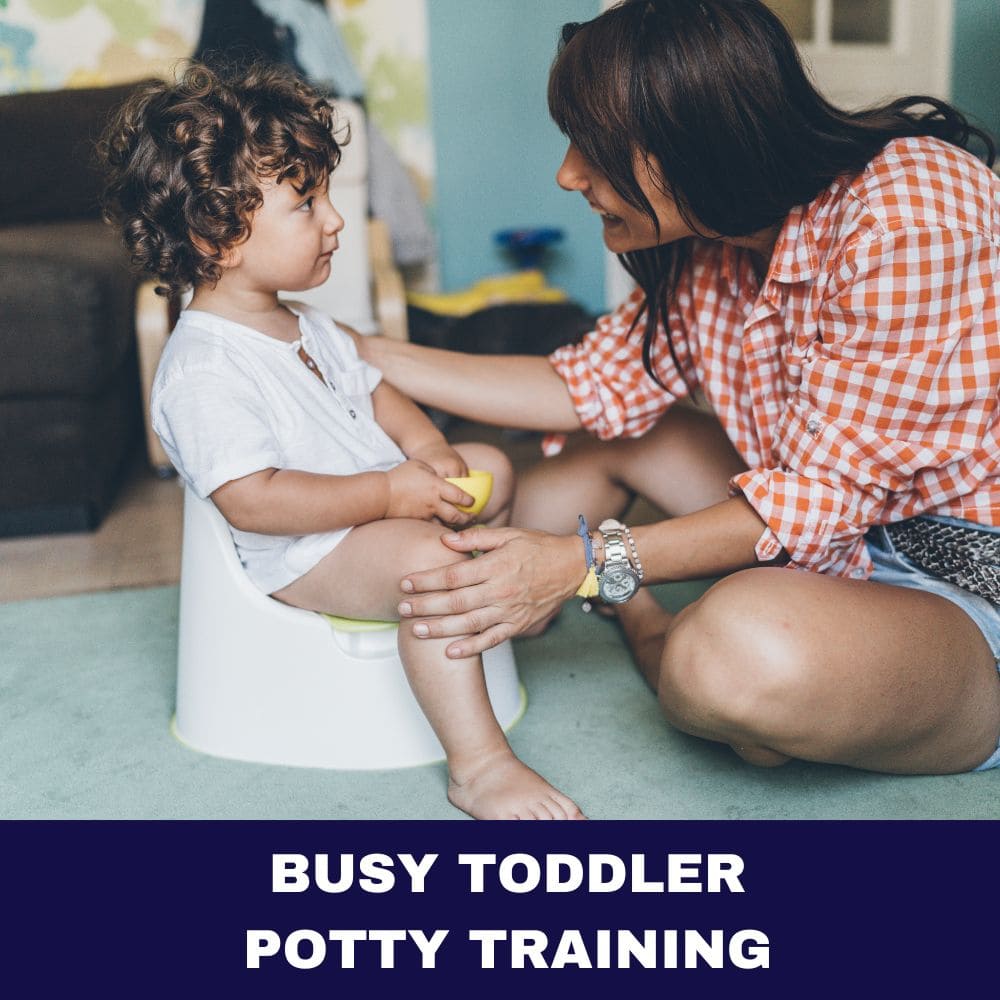Have you ever been at a family gathering or a crowded public place when suddenly, your toddler starts clutching their ears, eyes squeezed shut, with a look of sheer distress on their face? It’s a heartbreaking sight that leaves many parents puzzled and unsure of how to respond. If this scenario resonates with you, you’re not alone. Covering ears is a common reaction among young children, but it can stem from various underlying causes, ranging from simple sensory sensitivity to more complex conditions.
In this comprehensive guide, we’ll explore the different reasons why toddlers cover their ears and provide you with seven calming techniques to help soothe and support your overwhelmed tot. So, let’s dive in!

Understanding Toddler Ear Covering Behavior
Toddlers covering their ears can be a sign of several conditions, and it’s essential to observe your child’s physical cues and day-to-day activities to identify the potential cause. Here are some common reasons why toddlers may cover their ears:
Conditions and Causes of Ear Covering
- Sensitivity to Sound: Toddlers have developing sensory systems, and loud or unexpected noises can be overwhelming for their delicate ears. This sensitivity can lead them to cover their ears as a protective measure.
- Ear Infection: Ear infections can cause significant discomfort and pain, prompting toddlers to cover their ears in an attempt to alleviate the pressure or block out sounds that exacerbate the pain.
- Autism Spectrum Disorder (ASD): Children with ASD may exhibit sensory processing difficulties, including auditory sensitivity. Covering their ears could be a coping mechanism to block out overwhelming sounds.
- Tinnitus (Ringing in the Ears): While relatively uncommon in toddlers, tinnitus can occur due to various factors, such as ear infections, loud noises, or even certain medications. The constant ringing or buzzing sound can be distressing, leading toddlers to cover their ears.
- Fear or Anxiety: Unfamiliar or loud sounds, like thunder or fireworks, can trigger fear or anxiety in some toddlers, causing them to cover their ears as a self-soothing behavior.
| Cause | Description |
|---|---|
| Sensitivity to Sound | Loud or unexpected noises can be overwhelming for toddlers’ developing senses, leading them to cover their ears as a protective measure. |
| Ear Infection | Ear infections can cause significant discomfort and pain, prompting toddlers to cover their ears to alleviate the pressure or block out sounds that exacerbate the pain. |
| Autism Spectrum Disorder (ASD) | Children with ASD may exhibit sensory processing difficulties, including auditory sensitivity. Covering their ears could be a coping mechanism to block out overwhelming sounds. |
| Tinnitus (Ringing in the Ears) | While relatively uncommon in toddlers, tinnitus can be distressing, leading toddlers to cover their ears to block out the constant ringing or buzzing sound. |
| Fear or Anxiety | Unfamiliar or loud sounds, like thunder or fireworks, can trigger fear or anxiety in some toddlers, causing them to cover their ears as a self-soothing behavior. |
Sensory Overload and Auditory Sensitivity
One of the most common reasons for toddlers covering their ears is sensory overload, particularly related to auditory sensitivity. Toddlers’ developing senses can be easily overwhelmed by loud noises, crowded environments, and intense stimuli. Covering their ears is a natural coping mechanism to block out these overwhelming sensations.
It’s important to remember that every child is unique, and their sensory thresholds may vary. What seems like a manageable noise level to you could be overwhelming for your toddler’s delicate ears. Observing your child’s reactions and triggers can help you better understand their individual sensory needs.
Next Step: If you notice your toddler frequently covering their ears or exhibiting signs of sensory overload, consider consulting with a pediatric occupational therapist or child psychologist. They can provide valuable insights and strategies to help your child better manage their sensory processing challenges.
When Toddler Ear Covering Becomes a Concern
While occasional ear covering is a normal behavior for toddlers, persistent or excessive ear covering may indicate an underlying issue that requires further attention. Here are some signs that you should seek professional guidance:
- Persistent Ear Covering: If your toddler consistently covers their ears, even in quiet environments or during activities they typically enjoy, it could be a sign of a more serious condition, such as hearing loss or sensory processing disorders.
- Accompanying Behavioral Changes: If ear covering is accompanied by other concerning behaviors, such as increased irritability, difficulty sleeping, or developmental regression, it may be time to consult with a healthcare professional.
- Ear Discharge or Pain: If you notice any discharge or signs of pain in your toddler’s ears, it could be an indication of an ear infection or other medical issue that requires prompt medical attention.
- Delayed Speech or Language Development: If your toddler’s ear covering behavior is accompanied by delays in speech or language development, it may be a sign of hearing loss or other developmental concerns.
It’s crucial to trust your parental instincts and seek professional guidance if you have any concerns about your toddler’s ear covering behavior or overall development.
Next Step: If you suspect that your toddler’s ear covering is more than just a passing phase, schedule an appointment with your pediatrician. They can perform a thorough examination, rule out any medical issues, and provide referrals to specialists if needed, such as an audiologist or developmental pediatrician.
| Sign | Explanation |
|---|---|
| Persistent Ear Covering | If your toddler consistently covers their ears, even in quiet environments or during activities they typically enjoy, it could be a sign of a more serious condition, such as hearing loss or sensory processing disorders. |
| Accompanying Behavioral Changes | If ear covering is accompanied by other concerning behaviors, such as increased irritability, difficulty sleeping, or developmental regression, it may be time to consult with a healthcare professional. |
| Ear Discharge or Pain | Any discharge or signs of pain in your toddler’s ears could be an indication of an ear infection or other medical issue that requires prompt medical attention. |
| Delayed Speech or Language Development | If your toddler’s ear covering behavior is accompanied by delays in speech or language development, it may be a sign of hearing loss or other developmental concerns. |
7 Calming Techniques for Overwhelmed Toddlers
Now that we’ve explored the potential causes of toddler ear covering, let’s dive into seven effective calming techniques to help soothe and support your overwhelmed tot:
- Create a Quiet Space: Designate a quiet, low-stimulation area in your home where your toddler can retreat when feeling overwhelmed. This space should be free from loud noises, bright lights, and excessive visual clutter. Consider adding cozy blankets, soft lighting, and calming sensory toys. Having a designated “safe haven” can provide a sense of security and control for your toddler when they feel overstimulated.
- Use Noise-Canceling Headphones: Invest in a pair of high-quality, child-sized noise-canceling headphones. These can be particularly helpful in noisy environments or during situations that may trigger sensory overload, such as family gatherings or public events. With the ability to block out overwhelming sounds, your toddler may feel more relaxed and in control of their sensory experience.
- Introduce Deep Breathing Exercises: Teaching your toddler simple deep breathing techniques can help them self-regulate and calm down when feeling overwhelmed. Start by encouraging them to take slow, deep breaths and exhale slowly, focusing on the sensation of their breath. You can make it more engaging by using visuals, such as blowing bubbles or moving a feather with their breath. Deep breathing not only calms the body but also promotes mindfulness and self-awareness.
- Engage in Calming Activities: Identify activities that help your toddler relax, such as coloring, playing with playdough, or listening to soothing music. Engaging in these calming activities can serve as a positive coping mechanism during moments of sensory overload. It’s essential to have a repertoire of activities that your toddler finds enjoyable and soothing, so you can easily redirect their attention when needed.
- Provide Sensory Toys and Fidgets: Sensory toys and fidgets can be incredibly helpful for toddlers who need to release pent-up energy or focus their attention. Consider offering items like stress balls, textured toys, or even simple household objects like bubbles or Play-Doh. These tactile experiences can provide a healthy outlet for sensory input and help regulate their emotions.
- Teach Sign Language for “Too Loud”: Teaching your toddler a simple sign language gesture for “too loud” can empower them to communicate their needs more effectively, especially in situations where verbal communication may be challenging. By giving them a non-verbal way to express their discomfort, you can respond promptly and help them feel understood and supported.
- Model Coping Strategies: As a parent, it’s essential to model healthy coping strategies for dealing with overwhelming situations. When you feel overwhelmed, demonstrate deep breathing exercises or take a break in a quiet space. Toddlers learn by observing and imitating those around them, so by showcasing positive coping mechanisms, you’re providing them with valuable life skills.
Next Step: Experiment with these calming techniques and observe which ones resonate most with your toddler. Every child is unique, so be prepared to adjust and find the right combination of strategies that work best for your family. Consistency and patience are key when introducing new coping mechanisms to your toddler.

Building Toddler Resilience and Self-Regulation Skills
While implementing calming techniques can provide immediate relief for an overwhelmed toddler, it’s equally important to focus on building their resilience and self-regulation skills. These essential abilities will serve them well as they navigate the challenges of growing up and encountering new sensory experiences.
Here are some strategies to help foster resilience and self-regulation in your toddler:
- Sensory Play: Engage your toddler in various sensory activities, such as finger painting, playing with textured materials, or exploring different sounds and textures. These experiences help desensitize them to stimuli that may initially be overwhelming while also promoting self-regulation skills.
- Establish Routines: Toddlers thrive on predictability and routines. Create a consistent schedule for activities, meals, and bedtime, as this can provide a sense of security and help them manage transitions more effectively.
- Use Visual Aids: Implement visual aids, such as picture schedules or emotion charts, to help your toddler understand and communicate their feelings. This can empower them to identify and express their emotions effectively, leading to better self-regulation.
- Positive Reinforcement: Praise and encourage your toddler when they display resilience or self-regulation skills. This positive reinforcement will motivate them to continue using these strategies and build their confidence in managing overwhelming situations.
- Lead by Example: As mentioned earlier, modeling healthy coping strategies is crucial. When faced with stressful situations, demonstrate how to take deep breaths, use calming self-talk, or engage in a relaxing activity. Your toddler will learn from your example and be more likely to emulate these positive behaviors.
Next Step: Incorporate sensory play, routines, visual aids, and positive reinforcement into your daily routine. Consistency and patience are key as you help your toddler develop these essential life skills. Remember, building resilience and self-regulation is an ongoing process, and celebrating small victories along the way can go a long way in encouraging your toddler’s progress.
Creating a Supportive Environment for Sensitive Tots
While building resilience and teaching calming techniques are important, it’s also crucial to create a supportive environment that accommodates your toddler’s sensory needs. By making simple adjustments to your home and daily routines, you can alleviate stress and prevent potential meltdowns caused by sensory overload.
Here are some strategies to create a more sensory-friendly environment for your sensitive tot:
- Reduce Noise Levels: Identify sources of loud or unexpected noises in your home, such as television volumes, appliances, or outdoor sounds, and take steps to minimize or eliminate them. Consider using noise-canceling curtains or rugs to absorb sound, or invest in white noise machines to create a calming auditory backdrop.
- Minimize Visual Clutter: Overstimulating visual environments can be overwhelming for toddlers with sensory sensitivities. Keep play areas and living spaces organized and free from excessive clutter, bright colors, or distracting patterns.
- Provide Cozy Spaces: Designate a cozy, dimly lit space in your home where your toddler can retreat when feeling overwhelmed. This could be a quiet corner with soft blankets, pillows, and calming sensory toys or books.
- Adjust Lighting: Bright, fluorescent lighting can be jarring for some toddlers. Consider using softer, natural lighting or investing in dimmable bulbs to create a more soothing atmosphere.
- Establish Sensory Breaks: Incorporate regular sensory breaks into your daily routine, especially after periods of intense stimulation, such as outings or social gatherings. These breaks can involve quiet time in a low-sensory environment or engaging in calming activities like deep breathing or gentle stretches.
By creating a supportive, sensory-friendly environment, you can help your toddler feel more comfortable and reduce the likelihood of sensory overload, ultimately promoting their overall well-being and development.
Next Step: Assess your home environment and identify areas that may be contributing to sensory overload for your toddler. Start by implementing small changes, such as reducing noise levels or minimizing visual clutter, and observe how your toddler responds. Remember, creating a supportive environment is an ongoing process, and you may need to make adjustments as your toddler’s needs evolve.
Potty Training Readiness and Strategies
Potty training is another significant milestone in a toddler’s development, and it’s a process that can be closely tied to their sensory experiences. Many parents find that introducing potty training during periods of sensory overload or heightened sensitivity can be counterproductive. Instead, it’s essential to wait for signs of readiness and approach the process with patience and understanding.
Here are some key considerations when it comes to potty training readiness and strategies:
- What does it really mean to be potty trained? Potty training is more than just staying dry during the day. It involves recognizing the urge to go, communicating that need, and being able to undress, use the toilet, and redress independently.
- Signs your toddler is ready to potty train: Look for indicators such as staying dry for longer periods, showing interest in the potty or imitating others, and being able to follow simple instructions. Generally, most toddlers are ready between 18-24 months.
- When is the best time to potty train? Timing is crucial. Avoid introducing potty training during periods of transition, such as a new sibling, moving homes, or starting daycare/preschool. Wait for a relatively stable and consistent period in your toddler’s life.
- How to potty train a toddler, according to experts: There are various methods, including the child-oriented approach, where you follow your toddler’s cues, and the more structured, parent-led approaches. Consistency, positive reinforcement, and patience are key, regardless of the method you choose.
- What about all the three-day potty training methods online? While these methods claim quick results, they may not be suitable for every child, especially those with sensory sensitivities or developmental delays. It’s best to approach potty training at your toddler’s pace.
Next Step: Observe your toddler for signs of readiness, and when the time is right, research different potty training methods to find the one that best suits your family’s needs. Remember, potty training is a journey, and setbacks are common. Celebrate small victories and remain patient throughout the process.
Potty Training Accessories and Rewards
To make potty training more engaging and enjoyable for your toddler, consider incorporating some fun accessories and reward systems. These can not only motivate your child but also help them feel more comfortable and in control during the process.
- What should you give as rewards for potty training? How do you use them? Sticker charts, small treats, or special outings can be effective rewards for successful potty trips. However, it’s important not to overdo it and to focus on positive reinforcement rather than punishment.
- Do you need a small potty or training seat? Having a child-sized potty or training seat can make the transition more comfortable for your toddler. Look for models with fun designs or characters to make it more appealing.
- What should your child wear after potty training? Once your toddler has mastered using the potty, transitioning to training pants or pull-ups can be a good intermediate step before moving to regular underwear.
Next Step: Involve your toddler in the process of selecting potty training accessories and rewards. This can help build their excitement and sense of ownership over the process. Remember, the key is to make potty training a positive and rewarding experience for both you and your child.
| Strategy | Description |
|---|---|
| Child-Friendly Accessories | Choose potty training accessories and rewards that appeal to your child’s senses, such as soft training pants or stickers with interesting textures. |
| Consistent Routine | Create a calm and consistent potty training routine to minimize sensory overload and provide a sense of predictability for your toddler. |
| Positive Reinforcement | Use positive reinforcement, such as praise or small rewards, to encourage your toddler’s progress and make potty training a positive experience. |
| Patience and Understanding | Approach potty training with patience and understanding, as every child has their own pace and sensory preferences. Avoid punishing or shaming your child for accidents. |
Handling Potty Training Challenges
While potty training can be a rewarding experience, it’s not without its challenges. Regression, frustration, and differences in readiness between genders are common hurdles that parents may face. Here’s what you need to know:
- Are regressions in potty training normal? Yes, regressions are common and can be triggered by various factors, such as stress, illness, or even developmental milestones. Remain patient and consistent, and avoid punishing your toddler for accidents.
- Do girls really potty train quicker than boys? Research suggests that girls may acquire potty training skills slightly earlier than boys, but individual differences play a significant role. Avoid comparing your child’s progress to others.
- How long does potty training take? There’s no one-size-fits-all timeline. Some toddlers may get the hang of it within a few weeks, while others may take several months. The key is to respect your child’s pace and not rush the process.
Next Step: If you encounter challenges during potty training, don’t hesitate to seek advice from your pediatrician, child development experts, or other experienced parents. Remember, every child is unique, and what works for one may not work for another. Remain patient, flexible, and willing to adjust your approach as needed.
Seeking Professional Help for Persistent Ear Covering
While many cases of toddler ear covering can be managed with the strategies and techniques outlined in this guide, there may be instances where professional support is necessary. If your toddler’s ear-covering behavior persists or is accompanied by other concerning symptoms, it’s important to seek guidance from qualified professionals.
Here are some situations where you may want to consider consulting with a healthcare provider:
- Persistent Ear Covering Despite Interventions: If your toddler continues to cover their ears excessively, even after implementing calming techniques and creating a supportive environment, it may be time to consult with a professional.
- Accompanying Developmental Delays: If your toddler’s ear covering behavior is accompanied by delays in speech, language, or other developmental milestones, it could be an indication of an underlying condition that requires further evaluation.
- Suspected Hearing Loss: If you suspect that your toddler’s ear covering behavior may be related to hearing difficulties, it’s crucial to schedule an appointment with an audiologist for a comprehensive hearing evaluation.
- Sensory Processing Disorders: If your toddler exhibits extreme sensitivity to various sensory stimuli, not just auditory, it may be beneficial to consult with an occupational therapist specializing in sensory processing disorders.
- Concerns About Autism or Other Neurodevelopmental Conditions: If your toddler’s ear covering behavior is accompanied by other signs that raise concerns about autism spectrum disorder or other neurodevelopmental conditions, it’s advisable to seek an evaluation from a developmental pediatrician or child psychologist.
Remember, seeking professional help is not an admission of failure as a parent; rather, it’s a proactive step toward understanding your toddler’s unique needs and providing the best possible support for their development and well-being.
Next Step: If you have concerns about your toddler’s ear covering behavior or overall development, schedule an appointment with your pediatrician. They can provide valuable guidance, perform necessary assessments, and refer you to appropriate specialists if needed.
Conclusion
In conclusion, toddler ear covering can be a puzzling and concerning behavior, but with the right knowledge and strategies, you can navigate this phase with ease. Remember, every child is unique, and what works for one may not work for another. The key is to remain patient, observant, and willing to seek professional guidance when needed.
By creating a supportive and understanding environment, you can help your overwhelmed tot feel safe, secure, and empowered to cope with sensory challenges. Embrace the journey, celebrate the small victories, and trust that with time and consistency, your little one will develop the resilience and self-regulation skills needed to thrive.
FAQ – Toddler Covering Ears
Is it normal for toddlers to cover their ears?
Yes, occasional ear covering is a common behavior in toddlers as they navigate the world of new sounds and sensory experiences. However, persistent or excessive ear covering may indicate an underlying issue that requires further attention.
How do I handle public situations when my toddler covers their ears?
Carry noise-canceling headphones or earplugs with you, and have a quiet space or distraction activity ready if your toddler becomes overwhelmed. Additionally, don’t be afraid to step outside or leave the situation if necessary.
Can ear covering lead to hearing problems or speech delays?
While ear covering itself does not directly cause hearing problems or speech delays, persistent covering could be a symptom of an underlying condition that may impact these areas of development. It’s important to monitor the behavior and seek professional guidance if concerned.
How can I make potty training easier for a sensory-sensitive toddler?
Choose potty training accessories and rewards that appeal to your child’s senses, such as soft training pants or stickers with interesting textures. Additionally, create a calm and consistent potty training routine to minimize sensory overload.
What if my toddler regresses after initially succeeding with potty training?
Regressions are common and can be triggered by various factors, such as stress, illness, or developmental milestones. Remain patient and consistent, and avoid punishing your child for accidents. If the regression persists, consult with your pediatrician for guidance.
By understanding and addressing these common concerns, you can better support your toddler’s unique needs and approach each developmental milestone with confidence and compassion.












